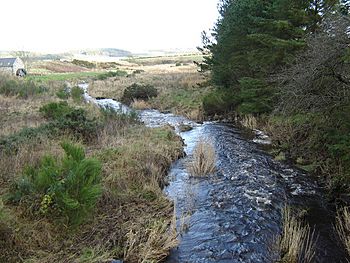Crynoch Burn facts for kids
Quick facts for kids Crynoch Burn |
|
|---|---|

Crynoch Burn
|
|
| Country | Scotland |
| Physical characteristics | |
| Main source | Nearby Netherley |
| River mouth | River Dee 57°05′38″N 2°14′12″W / 57.09383°N 2.23660°W |
The Crynoch Burn is a small stream in Aberdeenshire, Scotland. It's like a smaller river that flows into a bigger one. The Crynoch Burn is a tributary to the famous River Dee.
This stream starts its journey near a place called Netherley. From there, it flows past Netherley House and then enters the Red Moss. The Red Moss is a very important natural bog area. A bog is a type of wetland with lots of peat, which is partly decayed plant matter.
After leaving the Red Moss, the Crynoch Burn flows near the old Lairhillock Inn. It then passes by the village of Maryculter and goes through Oldman Wood. Finally, it joins the River Dee.
The water in the Crynoch Burn comes from different places. Its headwaters (where the stream begins) are on the northern and western sides of Meikle Carewe Hill. It also gets water from the northern slopes of Curlethney Hill.
The ground near where the Crynoch Burn meets the River Dee is light and sandy. The water itself is a greenish-brown color. Scientists measure how acidic or alkaline water is using something called the pH scale. The pH level of the Crynoch Burn's water is about 8.05, which means it's slightly alkaline.
Understanding the Water Flow
What is a Tributary?
A tributary is a smaller stream or river that flows into a larger river or lake. Think of it like a branch joining a main tree trunk. The Crynoch Burn is a tributary because it flows into the bigger River Dee.
How Water Levels are Measured
The Crynoch Burn has other smaller streams that flow into it. These are also its tributaries. One example is the Cairnie Burn.
Scientists use a system called the Strahler Stream Order to classify rivers and streams. This system helps them understand how many tributaries a stream has and how big it is. The Crynoch Burn is a "second order stream." This means it's formed when two "first order streams" (the smallest kind of streams) join together.

